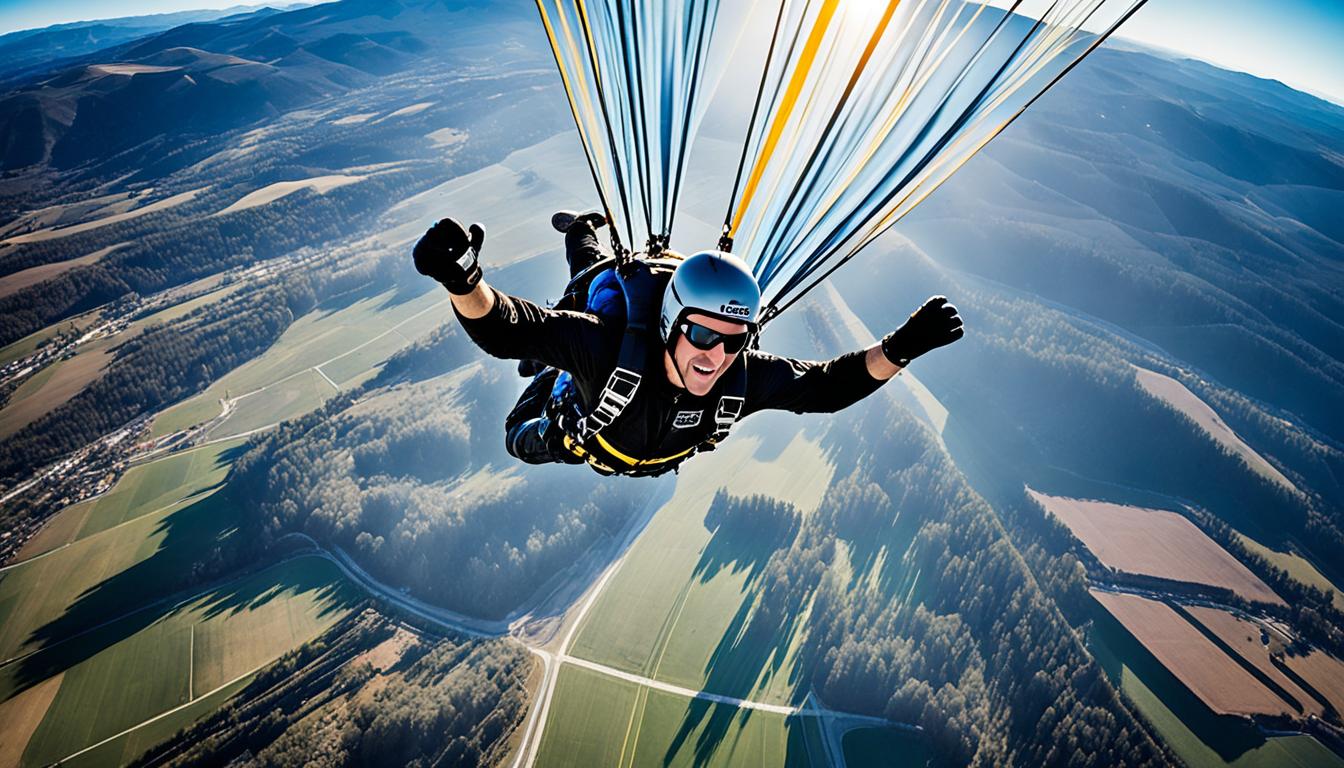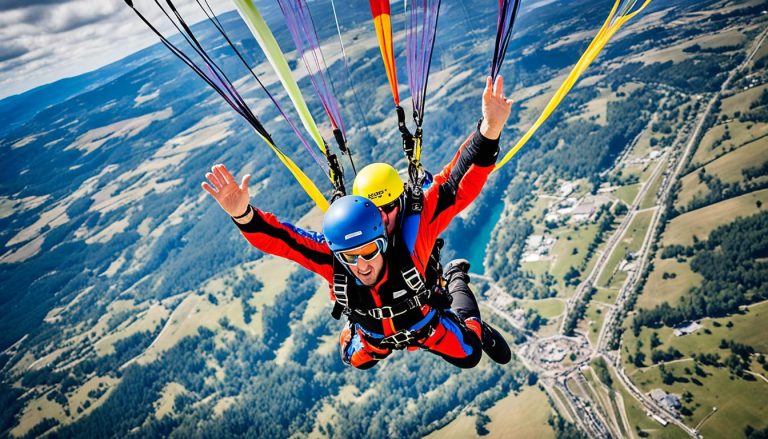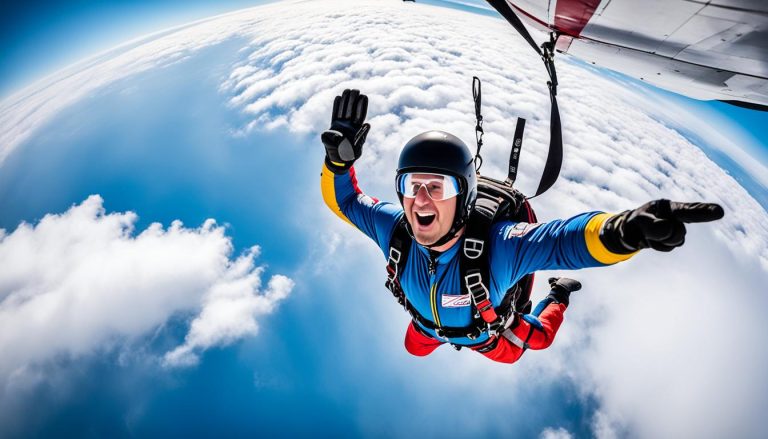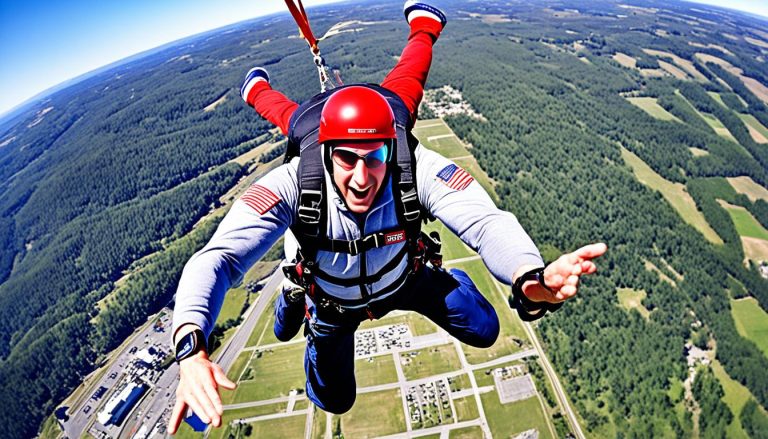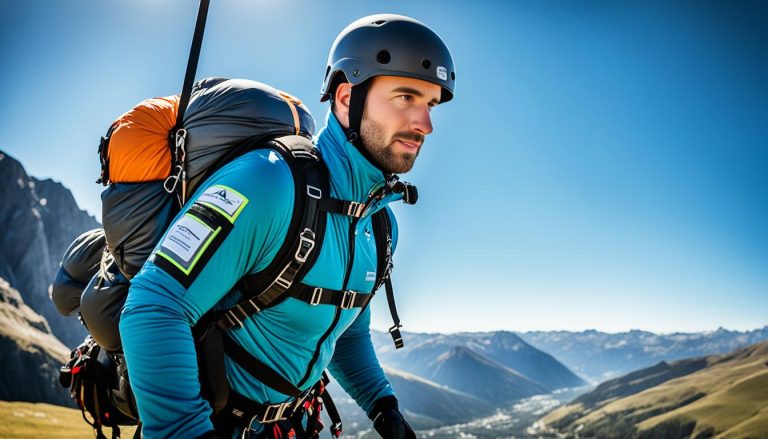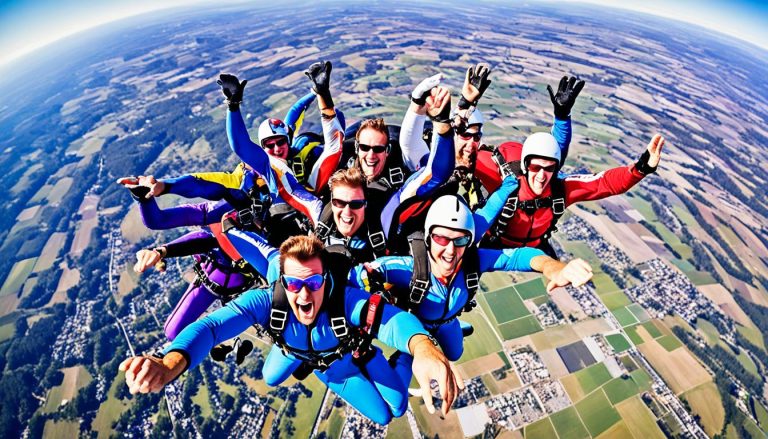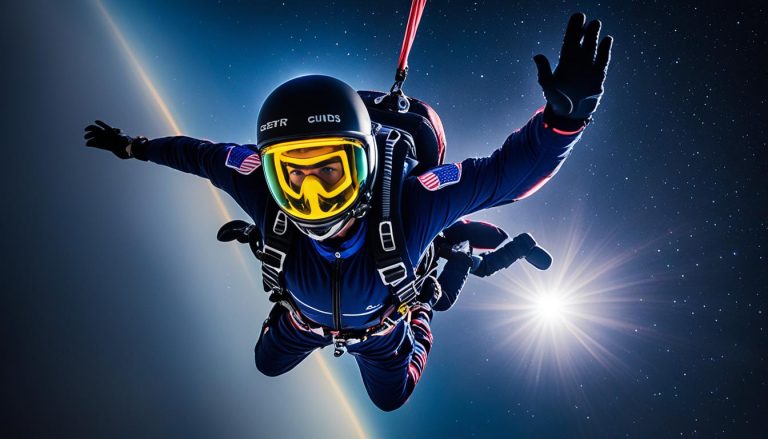Mastering the Art of Swooping during Parachuting
Parachute swooping is an exhilarating aspect of skydiving that involves executing precise landings and advanced flight control techniques. It is essential for skydivers to master the art of swooping in order to achieve accuracy and control during their descents. By learning the proper techniques and developing essential skills, skydivers can enhance their ability to perform swoop landings and control their canopy in advanced flight maneuvers.
This section will discuss the key techniques and skills necessary for mastering the art of swooping during parachuting. We will delve into parachute swooping techniques, focusing on advanced parachuting maneuvers that allow for precise control and accurate landings. Additionally, we will explore the swoop landing skills required to achieve precision in swooping, including the importance of wingloading, brake turns, and timing.
Moreover, we will examine the strategies for expert parachute flight control, which plays a vital role in executing successful swoop dives. It is important to note that safety is a fundamental aspect of parachute swooping, and we will outline safety measures and best practices that every swooper should adhere to.
Parachute Swooping Techniques
Parachute swooping is a thrilling aspect of skydiving that requires specific techniques to achieve precision and control during the descent. Skydivers who are serious about mastering parachute swooping must develop advanced parachuting maneuvers and undergo swoop accuracy training to perfect their skills. This section will explore the various techniques and maneuvers involved in parachute swooping, including the utilization of double front risers, site picture, input, release, and turning approaches.
To control the acceleration and dive of the canopy, skydivers employ advanced parachuting maneuvers such as the utilization of double front risers. These controls allow them to gain better control and execute high-performance turns during their descent. It is through these techniques that skydivers can achieve the precision and control required for a successful swoop landing.
Skydivers must also focus on developing their skills in site picture, input, release, and other important aspects of turning approaches. By mastering these techniques, they can assess their surroundings, efficiently maneuver their canopy, and execute precise landings. It is the combination of these skills that sets expert swoopers apart.
Swoop Accuracy Training
Swoop accuracy training is an integral part of mastering parachute swooping. This specialized training focuses on perfecting the timing and execution of swoop landings. It involves a series of drills and exercises designed to enhance a skydiver’s ability to control their canopy during the critical moments leading up to touchdown.
During swoop accuracy training, skydivers practice various approaches and landings, honing their ability to control their speed, distance, and accuracy. It is through repetitive practice that they develop the muscle memory necessary to execute precise landings consistently. This training also emphasizes safety and risk management, ensuring that skydivers are well-prepared to handle any unforeseen circumstances that may arise during their swoop landings.
With dedication, practice, and the proper training, skydivers can perfect their parachute swooping techniques and achieve greater control and precision during their descents.
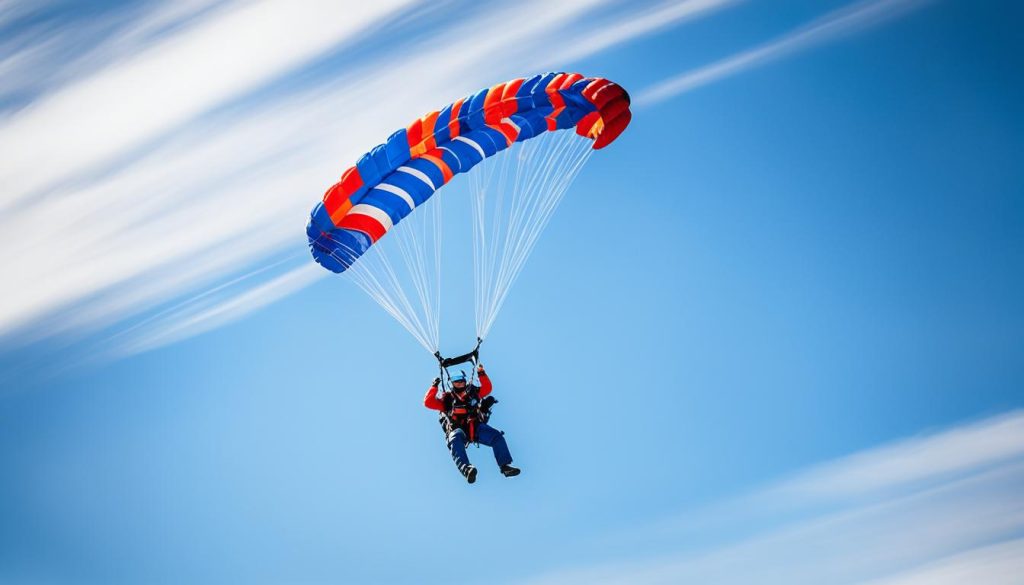
| Parachute Swooping Techniques | Benefits |
|---|---|
| Utilizing advanced parachuting maneuvers | – Control acceleration and dive of the canopy – Execute high-performance turns |
| Site picture, input, release, and turning approaches | – Assess surroundings – Efficiently maneuver the canopy – Execute precise landings |
| Swoop accuracy training | – Perfect timing and execution of swoop landings – Improve control over speed, distance, and accuracy |
Swoop Landing Skills
Achieving precision in swooping requires a combination of technical skills and finesse. Skydivers must develop the ability to assess their wingloading and choose a canopy that allows for a controlled descent. Additionally, they must learn the essentials of brake turns, flat turns, and other evasive maneuvers to ensure their safety and control during low swoop landings. Perfecting swoop landing skills involves understanding recovery arcs, sensitivity to inputs, and the importance of timing in executing precise landings. This section will explore the skills and techniques necessary for achieving precision in swooping.
Skydivers aiming to achieve precision in swooping must first focus on selecting the appropriate wingloading. Wingloading refers to the ratio of a skydiver’s body weight to the total area of the parachute canopy. It plays a crucial role in the control and handling of the canopy during the descent. A higher wingloading provides increased speed and maneuverability, but also demands more skill and control from the skydiver. It is essential to find the right balance that allows for controlled descents and accurate landing approaches.
One of the key skills for achieving precision in swooping is mastering brake turns. Brake turns involve manipulating the brake lines to induce a turn in the canopy. By pulling one brake line harder than the other, skydivers can initiate controlled turns. These turns are essential for adjusting the direction and angle of approach during the landing. It requires finesse and a deep understanding of how the canopy reacts to these inputs. Practice and refinement of brake turns are crucial for achieving accuracy in swoop landings.
Another essential technique for achieving precision in swooping is the execution of flat turns. Flat turns involve applying simultaneous and equal inputs on both brake lines to initiate a turn in the canopy. This technique allows skydivers to maintain a consistent descent path and avoid any lateral drift during low swoop landings. The mastery of flat turns requires precise control and coordination of the canopy, achieved through practice and proficiency.
The timing of inputs plays a crucial role in executing precise swoop landings. Skydivers must understand the recovery arcs of their canopy and make well-timed adjustments to achieve accurate landings. Recovery arcs refer to the path that the canopy follows as it recovers from a turn. Skydivers must anticipate and adjust their inputs accordingly to navigate the canopy through a smooth recovery arc, leading to a controlled and precise landing.
Sensitivity to inputs is another vital aspect of achieving precision in swooping. Skydivers must develop a keen sense of their canopy’s response to different input levels. By understanding the subtle cues and feedback from the canopy, they can make precise adjustments to control the descent path and landing approach. Developing this sensitivity requires experience, practice, and a deep connection with the canopy.
By honing their swoop landing skills, skydivers can achieve precision and control during their descents. It is essential to dedicate time and effort to practice and refine these techniques, gradually pushing the boundaries to improve accuracy and proficiency. The mastery of swoop landing skills opens up opportunities for more challenging and daring swoop landings, making the experience even more exhilarating for skydivers.
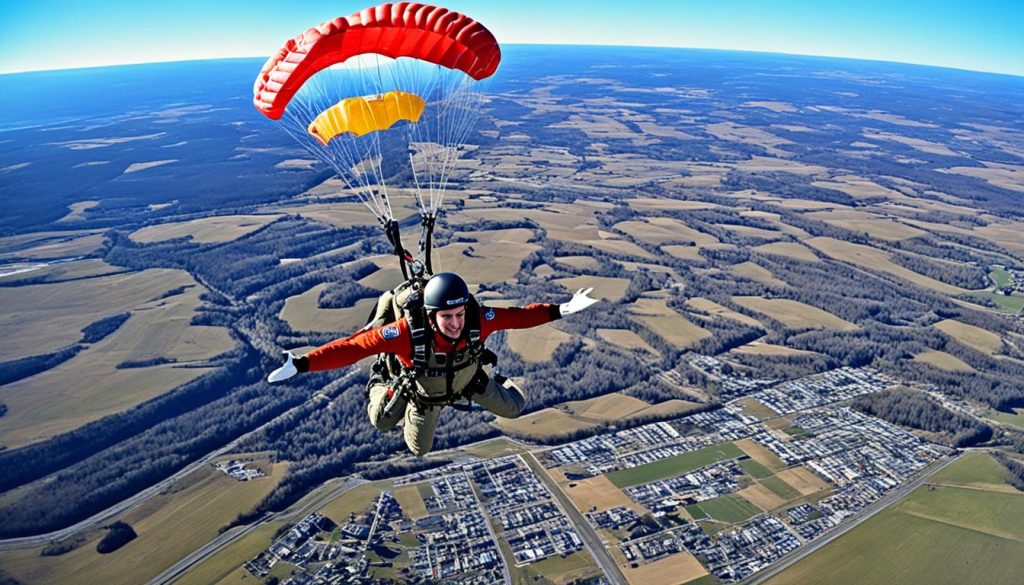
Expert Parachute Flight Control
Expert parachute flight control plays a crucial role in executing successful swoop dives. It requires a deep understanding of canopy dynamics and the ability to effectively utilize control inputs. Skydivers who master expert parachute flight control can achieve high-performance turns and maneuver their smaller, faster canopies with precision.
One of the key techniques for expert parachute flight control is the skillful use of double front risers. By manipulating these control lines, skydivers can control the acceleration and dive of their canopies, enabling them to execute dynamic turns and maneuvers during their descents.
Additionally, skydivers must develop a keen sense of speed and sensitivity when flying smaller, faster canopies. The increased speed poses a challenge in maintaining control and executing precise movements. Expert parachute flight control requires finesse and the ability to make subtle adjustments to maintain stability and control throughout the dive.
Skydivers can further enhance their flight control skills by practicing specific swoop dive techniques. These techniques involve executing aggressive turns, maintaining proper body position, and utilizing precise control inputs to achieve optimal performance during the dive.
Understanding the aerodynamic principles that govern canopy flight is essential for expert parachute flight control. Skydivers should familiarize themselves with concepts such as lift, drag, and steering inputs to make accurate control adjustments during their dives. This knowledge enables them to fine-tune their flight control techniques and optimize their performance.
By mastering expert parachute flight control, skydivers can take their swoop dives to the next level. They can execute impressive turns, fly at high speeds while maintaining control, and enhance their overall performance during their descents.
Swoop Dive Techniques
Swoop dive techniques are an integral part of expert parachute flight control. These techniques focus on executing dynamic turns and dives to achieve optimal performance during the descent.
- Aggressive Turns: Swoop dives require precise and aggressive turns to harness the full potential of the canopy’s performance. By utilizing control inputs and proper body positioning, skydivers can execute sharp turns during their dives, generating speed and momentum.
- Body Positioning: Maintaining the correct body position throughout the swoop dive is critical for stability and control. Skydivers need to be aware of their body’s relationship to the canopy and make adjustments accordingly to optimize their flight performance.
- Precision Control Inputs: Expert parachute flight control relies on precise control inputs to execute maneuvers effortlessly. By using the control toggles, brakes, and other control lines effectively, skydivers can make subtle adjustments to their canopy’s flight path, ensuring accurate execution of swoop dives.
The combination of expert parachute flight control and swoop dive techniques allows skydivers to perform breathtaking maneuvers and landings with precision. It is the culmination of skill, technique, and experience that makes swooping a thrilling and visually captivating aspect of skydiving.
Safety Measures and Best Practices
With the excitement and thrill of parachute swooping, skydivers must prioritize safety to ensure a safe and enjoyable experience. By following the recommended safety measures and best practices, skydivers can minimize the risks associated with this exhilarating activity.
Safety Measures
- Progress Gradually: Skydivers should start their swooping journey with low wingloadings and slower, docile canopies. This allows them to build a solid foundation of skills and knowledge before advancing to more challenging maneuvers.
- Education: It is crucial for skydivers to invest time in learning about canopy dynamics and the potential risks associated with higher wingloadings and faster canopies. This knowledge empowers them to make informed decisions and mitigate potential hazards.
- Practice Evasive Maneuvers: Incorporating regular practice of evasive maneuvers into training sessions is essential. This helps skydivers develop the necessary skills to react quickly and effectively in unexpected situations.
- Hone Emergency Response Skills: Skydivers should dedicate time to mastering emergency response skills, such as canopy collapses or line twists. Being prepared and knowing how to handle such situations can prevent accidents and ensure a safe landing.
Best Practices
- Stay within Personal Limits: It is important for skydivers to be aware of their skill level and only attempt maneuvers that are within their capabilities. Pushing boundaries without proper experience can lead to accidents and injuries.
- Communicate and Cooperate: Clear communication with other skydivers in the vicinity is crucial to prevent mid-air collisions and ensure a safe airspace. Cooperating with others and adhering to established skydiving protocols promotes overall safety.
- Perform Regular Equipment Checks: Skydivers should always perform thorough pre-flight checks to ensure their equipment is in optimal condition. This includes inspecting the parachute, harness, and other safety gear.
- Stay Physically Fit: Maintaining good physical fitness is essential for performing swooping maneuvers safely. Regular exercise and strength training can enhance coordination, agility, and overall performance.
By following these safety measures and best practices, skydivers can enjoy the exhilaration of parachute swooping while minimizing the potential risks associated with the sport.
Conclusion
In conclusion, mastering the art of swooping during parachuting requires a combination of skill, technique, and experience. By utilizing specific parachute swooping techniques, developing swoop landing skills, and practicing expert parachute flight control, skydivers can achieve precision and control during their descents. It is crucial, however, to prioritize safety and follow best practices for parachute swooping to ensure a safe and enjoyable experience.
With dedication and commitment to mastering the art of swooping, skydivers can elevate their skills and proficiency in this thrilling aspect of the sport. By continually honing their abilities and staying up-to-date with the latest safety guidelines, skydivers can push the boundaries of what is possible during parachute swooping, while also mitigating potential risks.
Whether you are a seasoned skydiver looking to enhance your swooping techniques or a beginner embarking on your first swoop, remember that it is essential to approach parachute swooping with caution and respect for the sport. By doing so, you can fully immerse yourself in the excitement and fulfillment that comes with mastering the art of swooping during parachuting.

